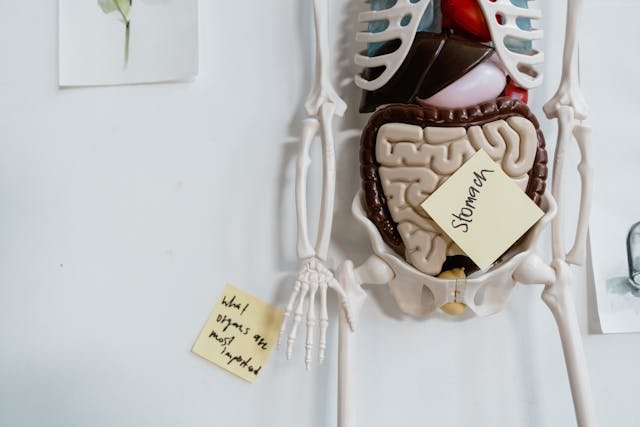

The Human Body in Norwegian: Internal Organs
Table of Contents
ToggleIntroduction
Understanding the human body and its intricate systems is crucial for anyone pursuing a career in healthcare or medical sciences. When studying or working in Norway, mastering the Norwegian terms for various body parts, especially internal organs, becomes essential. This comprehensive guide will walk you through the major internal organs of the human body, providing you with the Norwegian terminology, key concepts, and relevant medical vocabulary.
Before we delve into the details, we’d like to inform you that if you’re looking to enhance your Norwegian language skills in the medical field, we offer specialized group classes focusing on medical terminology. You can register for these classes at https://nlsnorwegian.no/group-norwegian-classes/. Our courses are designed to help you master medical vocabulary and improve your overall Norwegian proficiency.
The Importance of Learning Medical Norwegian
Acquiring proficiency in medical Norwegian is crucial for several reasons:
- Effective communication with patients and colleagues
- Accurate interpretation of medical records and research papers
- Participation in medical conferences and research initiatives in Norway
- Seamless navigation of the Norwegian healthcare system
- Enhanced career opportunities in the Norwegian medical field
- Better understanding of Norwegian medical literature and guidelines
- Improved ability to explain complex medical concepts to Norwegian patients
- Facilitation of smooth transitions between international and Norwegian medical practices
Now, let’s explore the Norwegian terms for major internal organs, their functions, and related medical vocabulary.
Hjertet (The Heart)
The heart, or “hjertet” in Norwegian, is the centerpiece of the cardiovascular system. This muscular organ pumps blood throughout the body, delivering oxygen and nutrients to tissues while removing waste products.
Key Norwegian terms related to the heart:
- Hjertekammer (Heart chamber)
- Hjerteklapp (Heart valve)
- Hjertemuskel (Heart muscle)
- Hjerteinfarkt (Heart attack)
- Hjerteslag (Heartbeat)
- Blodåre (Blood vessel)
- Aorta (Aorta)
- Forkammer (Atrium)
- Hjertekammer (Ventricle)
- Hjerterytme (Heart rhythm)
- Blodtrykk (Blood pressure)
- Hjertekransåre (Coronary artery)
- Hjertelyd (Heart sound)
- Perikard (Pericardium)
- Endokard (Endocardium)
Example sentences:
- “Pasienten har en unormal hjerterytme.” (The patient has an abnormal heart rhythm.)
- “EKG-en viser tegn på et tidligere hjerteinfarkt.” (The ECG shows signs of a previous heart attack.)
- “Kirurgen må reparere en defekt hjerteklapp.” (The surgeon needs to repair a defective heart valve.)
- “Vi hører en bilyd ved auskultasjon av hjertet.” (We hear a murmur when auscultating the heart.)
- “Pasienten har gjennomgått en bypass-operasjon for å forbedre blodtilførselen til hjertemuskelen.” (The patient has undergone a bypass surgery to improve blood supply to the heart muscle.)
Common heart conditions in Norwegian:
- Hjertesvikt (Heart failure)
- Hjertearytmi (Cardiac arrhythmia)
- Angina (Angina)
- Høyt blodtrykk (High blood pressure)
- Åreforkalkning (Atherosclerosis)
- Kardiomyopati (Cardiomyopathy)
- Endokarditt (Endocarditis)
- Medfødt hjertefeil (Congenital heart defect)
- Perikarditt (Pericarditis)
Lungene (The Lungs)
The lungs, or “lungene” in Norwegian, are the primary organs of the respiratory system. They facilitate gas exchange, bringing oxygen into the bloodstream and removing carbon dioxide.
Important Norwegian terms related to the lungs:
- Bronkier (Bronchi)
- Lungelapp (Lung lobe)
- Lungebetennelse (Pneumonia)
- Pustevansker (Breathing difficulties)
- Lungekapasitet (Lung capacity)
- Alveole (Alveolus)
- Luftrør (Trachea)
- Mellomgulv (Diaphragm)
- Oksygenmetning (Oxygen saturation)
- Spirometri (Spirometry)
- Brysthule (Thoracic cavity)
- Lungehinne (Pleura)
- Bronkioler (Bronchioles)
- Surfaktant (Surfactant)
- Gassutveksling (Gas exchange)
Example sentences:
- “Røntgenbildet viser tegn på lungebetennelse i høyre lunge.” (The X-ray shows signs of pneumonia in the right lung.)
- “Pasienten klager over pustevansker og hoste.” (The patient complains of breathing difficulties and cough.)
- “Vi må utføre en spirometri for å måle pasientens lungekapasitet.” (We need to perform a spirometry to measure the patient’s lung capacity.)
- “Lungene er dekket av en beskyttende hinne kalt pleura.” (The lungs are covered by a protective membrane called the pleura.)
- “Surfaktant reduserer overflatespenningen i alveolene og hindrer dem i å kollapse.” (Surfactant reduces surface tension in the alveoli and prevents them from collapsing.)
Common lung conditions in Norwegian:
- Kronisk obstruktiv lungesykdom (KOLS) (Chronic Obstructive Pulmonary Disease – COPD)
- Astma (Asthma)
- Lungekreft (Lung cancer)
- Lungeemfysem (Emphysema)
- Bronkitt (Bronchitis)
- Lungeemboli (Pulmonary embolism)
- Cystisk fibrose (Cystic fibrosis)
- Pleuritt (Pleurisy)
- Tuberkulose (Tuberculosis)
Leveren (The Liver)
The liver, or “leveren” in Norwegian, is a vital organ that performs numerous functions, including detoxification, protein synthesis, and the production of biochemicals necessary for digestion.
Key Norwegian terms related to the liver:
- Leversvikt (Liver failure)
- Skrumplever (Cirrhosis)
- Galleblære (Gallbladder)
- Leverenzymer (Liver enzymes)
- Leverbiopsi (Liver biopsy)
- Galle (Bile)
- Leverlobber (Liver lobes)
- Leverceller (Hepatocytes)
- Fettlever (Fatty liver)
- Levertransplantasjon (Liver transplant)
- Leversinusoider (Liver sinusoids)
- Glykogenlagring (Glycogen storage)
- Leverregenerasjon (Liver regeneration)
- Portåre (Portal vein)
- Leverkapsel (Liver capsule)
Example sentences:
- “Blodprøvene viser forhøyede leverenzymer.” (The blood tests show elevated liver enzymes.)
- “Pasienten har utviklet skrumplever på grunn av langvarig alkoholmisbruk.” (The patient has developed cirrhosis due to long-term alcohol abuse.)
- “Vi må utføre en leverbiopsi for å bekrefte diagnosen.” (We need to perform a liver biopsy to confirm the diagnosis.)
- “Leveren har en bemerkelsesverdig evne til å regenerere seg selv.” (The liver has a remarkable ability to regenerate itself.)
- “Galleblæren lagrer og konsentrerer galle produsert av leveren.” (The gallbladder stores and concentrates bile produced by the liver.)
Common liver conditions in Norwegian:
- Hepatitt (Hepatitis)
- Leverkreft (Liver cancer)
- Gallesten (Gallstones)
- Alkoholisk leversykdom (Alcoholic liver disease)
- Autoimmun leversykdom (Autoimmune liver disease)
- Wilsons sykdom (Wilson’s disease)
- Hemokromatose (Hemochromatosis)
- Primær biliær kolangitt (Primary biliary cholangitis)
- Leverkoma (Hepatic encephalopathy)
Nyrene (The Kidneys)
The kidneys, or “nyrene” in Norwegian, are bean-shaped organs that filter blood, remove waste products, and regulate electrolyte balance in the body.
Important Norwegian terms related to the kidneys:
- Nyrestein (Kidney stone)
- Nyresvikt (Kidney failure)
- Urinrør (Urethra)
- Dialyse (Dialysis)
- Nyretransplantasjon (Kidney transplant)
- Nefron (Nephron)
- Urinblære (Urinary bladder)
- Ureter (Ureter)
- Kreatinin (Creatinine)
- Glomerulus (Glomerulus)
- Nyrebekken (Renal pelvis)
- Nyrekapsel (Renal capsule)
- Nyremarg (Renal medulla)
- Nyrebark (Renal cortex)
- Filtrasjon (Filtration)
Example sentences:
- “Pasienten må gjennomgå dialyse på grunn av kronisk nyresvikt.” (The patient must undergo dialysis due to chronic kidney failure.)
- “Ultralydundersøkelsen avslørte en stor nyrestein i høyre nyre.” (The ultrasound examination revealed a large kidney stone in the right kidney.)
- “Vi må overvåke pasientens kreatininnivåer nøye.” (We need to closely monitor the patient’s creatinine levels.)
- “Nefronet er den funksjonelle enheten i nyren.” (The nephron is the functional unit of the kidney.)
- “Glomerulus filtrerer blodet og danner primærurin.” (The glomerulus filters the blood and forms primary urine.)
Common kidney conditions in Norwegian:
- Nyrebetennelse (Nephritis)
- Cystenyrer (Polycystic kidney disease)
- Diabetisk nefropati (Diabetic nephropathy)
- Glomerulonefritt (Glomerulonephritis)
- Urinveisinfeksjon (Urinary tract infection)
- Hydronefrose (Hydronephrosis)
- Nyrearteriestenose (Renal artery stenosis)
- Nefrotisk syndrom (Nephrotic syndrome)
- Akutt tubulær nekrose (Acute tubular necrosis)
Magesekken (The Stomach)
The stomach, or “magesekken” in Norwegian, is a muscular organ that plays a crucial role in the digestive process, breaking down food and mixing it with gastric juices.
Key Norwegian terms related to the stomach:
- Magesår (Stomach ulcer)
- Fordøyelse (Digestion)
- Magesyre (Stomach acid)
- Kvalme (Nausea)
- Magekatarr (Gastritis)
- Mavesaft (Gastric juice)
- Nedre lukkemuskel (Lower esophageal sphincter)
- Tolvfingertarm (Duodenum)
- Oppkast (Vomiting)
- Refluks (Reflux)
- Kardia (Cardia)
- Pylorus (Pylorus)
- Mageslimhinne (Gastric mucosa)
- Peristaltikk (Peristalsis)
- Magesonde (Nasogastric tube)
Example sentences:
- “Pasienten klager over kraftige magesmerter og kvalme.” (The patient complains of severe stomach pain and nausea.)
- “Gastroskopien avslørte et aktivt magesår.” (The gastroscopy revealed an active stomach ulcer.)
- “Vi må undersøke om pasienten har tilstrekkelig produksjon av magesyre.” (We need to investigate if the patient has sufficient production of stomach acid.)
- “Refluks oppstår når mageinnhold strømmer tilbake opp i spiserøret.” (Reflux occurs when stomach contents flow back up into the esophagus.)
- “Mageslimhinnen produserer beskyttende slim for å forhindre skade fra magesyre.” (The gastric mucosa produces protective mucus to prevent damage from stomach acid.)
Common stomach conditions in Norwegian:
- Magesårsykdom (Peptic ulcer disease)
- Gastroøsofageal reflukssykdom (GERD) (Gastroesophageal reflux disease – GERD)
- Magekreft (Stomach cancer)
- Funksjonell dyspepsi (Functional dyspepsia)
- Helicobacter pylori-infeksjon (Helicobacter pylori infection)
- Gastroparese (Gastroparesis)
- Zollinger-Ellison syndrom (Zollinger-Ellison syndrome)
- Akutt gastritt (Acute gastritis)
- Magedilatation (Gastric dilatation)
Bukspyttkjertelen (The Pancreas)
The pancreas, or “bukspyttkjertelen” in Norwegian, is a glandular organ that plays a crucial role in digestion and blood sugar regulation.
Key Norwegian terms related to the pancreas:
- Diabetes (Diabetes)
- Insulin (Insulin)
- Bukspyttkjertelbetennelse (Pancreatitis)
- Fordøyelsesenzymer (Digestive enzymes)
- Blodsukkernivå (Blood sugar level)
- Langerhanske øyer (Islets of Langerhans)
- Glukagon (Glucagon)
- Eksokrin funksjon (Exocrine function)
- Endokrin funksjon (Endocrine function)
- Bukspyttkjertelgang (Pancreatic duct)
- Amylase (Amylase)
- Lipase (Lipase)
- Trypsin (Trypsin)
- Somatostatin (Somatostatin)
- Bukspyttkjertelhode (Pancreatic head)
Example sentences:
- “Pasienten har nylig fått diagnosen type 2 diabetes.” (The patient has recently been diagnosed with type 2 diabetes.)
- “Blodprøvene viser forhøyede nivåer av bukspyttkjertelenzymer.” (The blood tests show elevated levels of pancreatic enzymes.)
- “Vi må justere insulindosen basert på pasientens blodsukkernivå.” (We need to adjust the insulin dose based on the patient’s blood sugar level.)
- “Langerhanske øyer i bukspyttkjertelen produserer flere viktige hormoner.” (The islets of Langerhans in the pancreas produce several important hormones.)
- “Akutt bukspyttkjertelbetennelse kan være en livstruende tilstand.” (Acute pancreatitis can be a life-threatening condition.)
Common pancreatic conditions in Norwegian:
- Akutt bukspyttkjertelbetennelse (Acute pancreatitis)
- Kronisk bukspyttkjertelbetennelse (Chronic pancreatitis)
- Bukspyttkjertelkreft (Pancreatic cancer)
- Cystisk fibrose (Cystic fibrosis)
- Insulinom (Insulinoma)
- Pankreatisk pseudocyste (Pancreatic pseudocyst)
- Eksokin pankreasinsuffisiens (Exocrine pancreatic insufficiency)
- Glukagonom (Glucagonoma)
- Hereditær pankreatitt (Hereditary pancreatitis)
Tarmene (The Intestines)
The intestines, or “tarmene” in Norwegian, are divided into two main parts: tynntarmen (small intestine) and tykktarmen (large intestine). They play a crucial role in digestion and nutrient absorption.
Important Norwegian terms related to the intestines:
- Tynntarm (Small intestine)
- Tykktarm (Large intestine)
- Tolvfingertarm (Duodenum)
- Tomtarm (Jejunum)
- Krumtarm (Ileum)
- Blindtarm (Appendix)
- Endetarm (Rectum)
- Tarmflora (Gut flora)
- Peristaltikk (Peristalsis)
- Tarmslimhinne (Intestinal mucosa)
- Tarmtotter (Intestinal villi)
- Kolon (Colon)
- Tarmgass (Intestinal gas)
- Tarmslyng (Intestinal obstruction)
- Tarmkrøs (Mesentery)
Example sentences:
- “Pasienten har symptomer på irritabel tarmsyndrom.” (The patient has symptoms of irritable bowel syndrome.)
- “Koloskopien viste flere polypper i tykktarmen.” (The colonoscopy revealed several polyps in the large intestine.)
- “Vi må undersøke pasientens tarmflora for å utelukke en bakteriell ubalanse.” (We need to examine the patient’s gut flora to rule out a bacterial imbalance.)
- “Tarmtottene øker overflatearealet for næringsopptak i tynntarmen.” (The intestinal villi increase the surface area for nutrient absorption in the small intestine.)
- “Peristaltikk er de rytmiske sammentrekningene som flytter mat gjennom tarmsystemet.” (Peristalsis is the rhythmic contractions that move food through the intestinal system.)
Common intestinal conditions in Norwegian:
- Irritabel tarmsyndrom (IBS) (Irritable Bowel Syndrome – IBS)
- Inflammatorisk tarmsykdom (IBD) (Inflammatory Bowel Disease – IBD)
- Crohns sykdom (Crohn’s disease)
- Ulcerøs kolitt (Ulcerative colitis)
- Cøliaki (Celiac disease)
- Divertikulitt (Diverticulitis)
- Tarmkreft (Colorectal cancer)
- Laktoseintoleranse (Lactose intolerance)
- Gastroenteritt (Gastroenteritis)
Milten (The Spleen)
The spleen, or “milten” in Norwegian, is an organ that plays important roles in the immune system and blood filtration.
Key Norwegian terms related to the spleen:
- Miltkapsel (Splenic capsule)
- Rød pulpa (Red pulp)
- Hvit pulpa (White pulp)
- Miltfunksjon (Splenic function)
- Miltruptur (Splenic rupture)
- Miltarterien (Splenic artery)
- Miltvenen (Splenic vein)
- Miltsinusoider (Splenic sinusoids)
- Lymfocytter (Lymphocytes)
- Makrofager (Macrophages)
Example sentences:
- “Pasienten har en forstørret milt, noe som kan tyde på en blodsykdom.” (The patient has an enlarged spleen, which may indicate a blood disorder.)
- “Vi må vurdere å fjerne milten på grunn av gjentatte infeksjoner.” (We need to consider removing the spleen due to recurrent infections.)
- “Ultralydundersøkelsen viser en normal miltstørrelse.” (The ultrasound examination shows a normal spleen size.)
- “Milten spiller en viktig rolle i filtreringen av røde blodceller.” (The spleen plays an important role in filtering red blood cells.)
- “En miltruptur kan være en livstruende tilstand som krever umiddelbar kirurgisk behandling.” (A splenic rupture can be a life-threatening condition requiring immediate surgical treatment.)
Common splenic conditions in Norwegian:
- Miltforstørrelse (Splenomegaly)
- Miltabscess (Splenic abscess)
- Arvet sfærocytose (Hereditary spherocytosis)
- Miltinfarkt (Splenic infarction)
- Miltsarkoidose (Splenic sarcoidosis)
- Miltcyste (Splenic cyst)
- Milttorsjon (Splenic torsion)
- Milttuberkulose (Splenic tuberculosis)
Skjoldbruskkjertelen (The Thyroid Gland)
The thyroid gland, or “skjoldbruskkjertelen” in Norwegian, is an endocrine gland that produces thyroid hormones, which regulate metabolism, growth, and development.
Important Norwegian terms related to the thyroid:
- Skjoldbruskhormon (Thyroid hormone)
- Tyroksin (Thyroxine)
- Trijodtyronin (Triiodothyronine)
- Stoffskifte (Metabolism)
- Struma (Goiter)
- Skjoldbruskkjertelknute (Thyroid nodule)
- Jod (Iodine)
- Tyreoideastimulerende hormon (TSH) (Thyroid-stimulating hormone)
- Skjoldbruskkjertelbetennelse (Thyroiditis)
- Autoimmun tyreoiditt (Autoimmune thyroiditis)
Example sentences:
- “Blodprøvene viser forhøyede nivåer av skjoldbruskhormon.” (The blood tests show elevated levels of thyroid hormone.)
- “Pasienten har symptomer på lavt stoffskifte.” (The patient has symptoms of low metabolism.)
- “Vi må utføre en finnålsbiopsi av knuten i skjoldbruskkjertelen.” (We need to perform a fine-needle biopsy of the nodule in the thyroid gland.)
- “Jod er nødvendig for produksjonen av skjoldbruskhormoner.” (Iodine is necessary for the production of thyroid hormones.)
- “Autoimmun tyreoiditt kan føre til både hyper- og hypotyreose.” (Autoimmune thyroiditis can lead to both hyperthyroidism and hypothyroidism.)
Common thyroid conditions in Norwegian:
- Hypotyreose (Hypothyroidism)
- Hypertyreose (Hyperthyroidism)
- Hashimotos sykdom (Hashimoto’s disease)
- Graves’ sykdom (Graves’ disease)
- Skjoldbruskkjertelkreft (Thyroid cancer)
- Subakutt tyreoiditt (Subacute thyroiditis)
- Toksisk knutestruma (Toxic nodular goiter)
- Tyreoideastorm (Thyroid storm)
Binyrene (The Adrenal Glands)
The adrenal glands, or “binyrene” in Norwegian, are endocrine glands located on top of the kidneys. They produce several important hormones.
Key Norwegian terms related to the adrenal glands:
- Binyrebark (Adrenal cortex)
- Binyremarg (Adrenal medulla)
- Kortisol (Cortisol)
- Adrenalin (Adrenaline)
- Aldosteron (Aldosterone)
- Binyrebarkhormoner (Adrenocortical hormones)
- Stressrespons (Stress response)
- Binyresvikt (Adrenal insufficiency)
- Binyrekreft (Adrenal cancer)
- Feokromocytom (Pheochromocytoma)
Example sentences:
- “Pasienten har symptomer på Cushings syndrom, som kan skyldes for høy kortisolproduksjon.” (The patient has symptoms of Cushing’s syndrome, which may be due to excessive cortisol production.)
- “Vi må måle pasientens aldosteronnivåer for å utelukke primær hyperaldosteronisme.” (We need to measure the patient’s aldosterone levels to rule out primary hyperaldosteronism.)
- “Binyrebarken produserer flere viktige hormoner, inkludert kortisol og aldosteron.” (The adrenal cortex produces several important hormones, including cortisol and aldosterone.)
- “Adrenalin frigjøres fra binyremargene som en del av kroppens ‘kjemp eller flykt’-respons.” (Adrenaline is released from the adrenal medulla as part of the body’s ‘fight or flight’ response.)
- “Binyresvikt kan være livstruende og krever hormonerstatningsterapi.” (Adrenal insufficiency can be life-threatening and requires hormone replacement therapy.)
Common adrenal gland conditions in Norwegian:
- Addisons sykdom (Addison’s disease)
- Cushings syndrom (Cushing’s syndrome)
- Feokromocytom (Pheochromocytoma)
- Conns syndrom (Conn’s syndrome)
- Binyrebarksvikt (Adrenal insufficiency)
- Medfødt binyrebarkhyperplasi (Congenital adrenal hyperplasia)
- Binyreincidentalom (Adrenal incidentaloma)
- Adrenogenitalt syndrom (Adrenogenital syndrome)
Conclusion
Mastering medical Norwegian terminology, particularly related to internal organs, is crucial for effective communication in healthcare settings in Norway. This comprehensive guide has covered the major internal organs, their functions, and associated medical vocabulary in Norwegian.
Remember, if you want to improve your medical Norwegian skills further, you can sign up for our specialized group classes at https://nlsnorwegian.no/group-norwegian-classes/. These classes will help you deepen your understanding of medical terminology and improve your overall Norwegian language skills.
Learning medical Norwegian is an ongoing process that requires dedication and practice. By familiarizing yourself with these terms and using them in context, you’ll be well-equipped to discuss human anatomy, diagnose conditions, and communicate effectively with patients and colleagues in Norwegian healthcare settings.
As you continue your journey in mastering medical Norwegian, remember to:
- Practice regularly, using flashcards or language learning apps to reinforce your vocabulary.
- Read Norwegian medical literature and journals to expose yourself to more advanced terminology and usage.
- Engage in conversations with Norwegian-speaking healthcare professionals to improve your fluency and comprehension.
- Stay updated on new medical developments and their corresponding Norwegian terminology.
- Consider participating in medical conferences or workshops conducted in Norwegian to further immerse yourself in the language.
- Use online resources and medical dictionaries to expand your knowledge of specialized terms.
- Practice explaining medical concepts in Norwegian to improve your ability to communicate with patients.
- Familiarize yourself with Norwegian medical abbreviations and acronyms commonly used in clinical settings.
By investing time and effort into learning medical Norwegian, you’ll not only enhance your language skills but also open up new opportunities in the Norwegian healthcare system. Whether you’re a medical student, a practicing healthcare professional, or simply interested in the field, this knowledge will serve you well in your academic and professional endeavors in Norway.
Remember that language learning is a journey, and every step you take brings you closer to your goal of mastering medical Norwegian. With persistence and dedication, you’ll soon find yourself confidently discussing complex medical topics in Norwegian, enhancing your ability to provide quality care and contribute to the Norwegian healthcare community.
If you want to learn Norwegian, you can register for classes here. We look forward to hearing from you and helping you become fluent in Norwegian.





